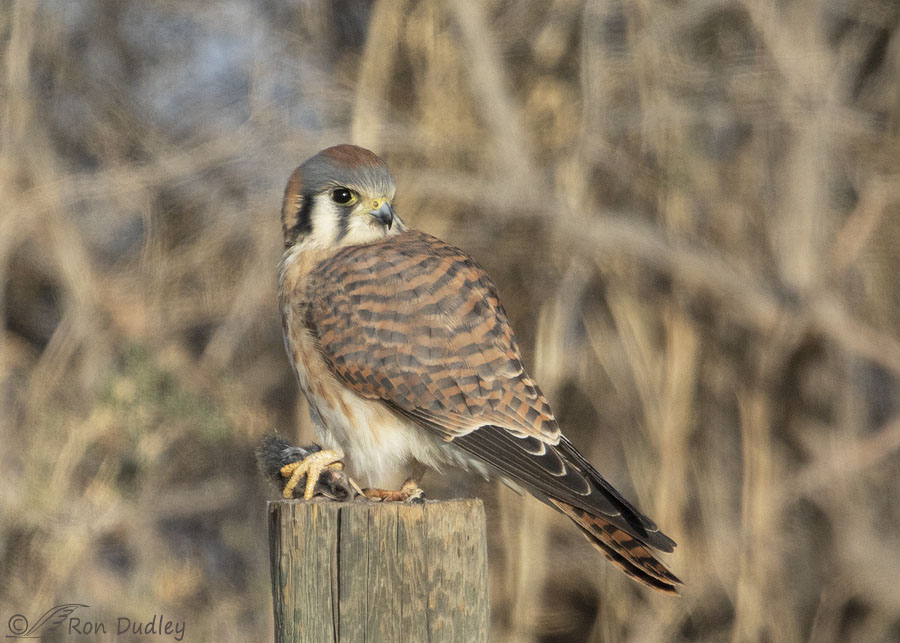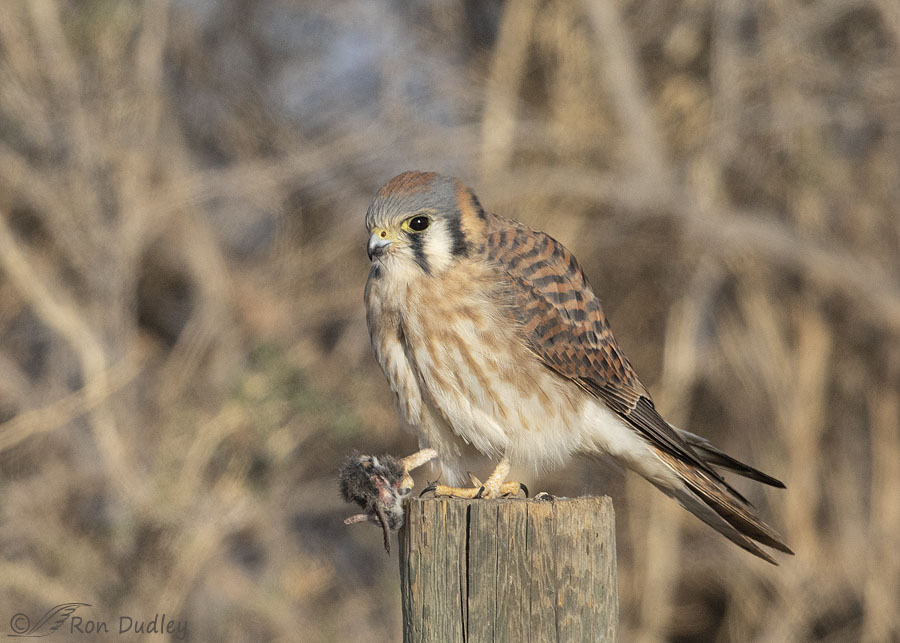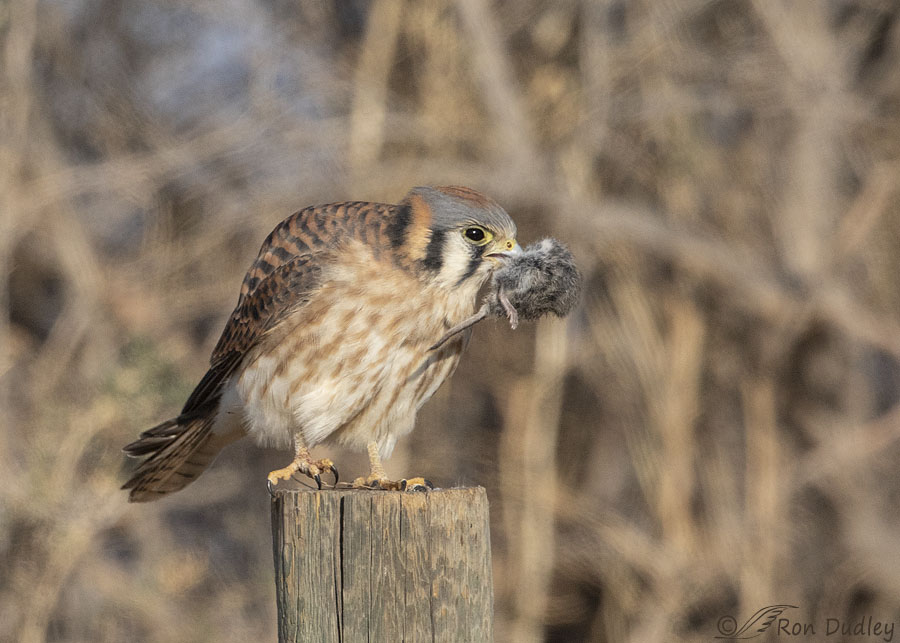To say that a kestrel of either sex has an attitude probably approaches redundancy but this little lady had one in spades.

1/5000, f/6.3, ISO 800, Canon 7D Mark II, Canon EF 500mm f/4L IS II USM + EF 1.4 III Extender, not baited, set up or called in
A week ago today I found her on top of a sign post enjoying a main course of vole. I’ll admit to feeling some guilt about approaching her because she obviously didn’t enjoy having an audience during her meal. For much of the time I was with her she just glared at me as she tried to decide whether to continue her repast or fly off with it.
The greasewood in the background is busy and unattractive but I’ll put a kestrel with prey in my viewfinder no matter the setting.

1/5000, f/6.3, ISO 800, Canon 7D Mark II, Canon EF 500mm f/4L IS II USM + EF 1.4 III Extender, not baited, set up or called in
When she turned more toward me and lifted what was left of the vole in her right foot I had hopes for takeoff shots but with her attitude she had no intention of being cooperative.

1/5000, f/6.3, ISO 800, Canon 7D Mark II, Canon EF 500mm f/4L IS II USM + EF 1.4 III Extender, not baited, set up or called in
She turned on her perch, put what was left of the rodent in her beak and soon took off to my right and away from me. I have more than enough butt shots, thank you.
Readers have probably noticed that these photos aren’t quite up to my usual sharpness standards. Getting sharp shots of birds is hard enough when the photographer does everything right but when you throw operator error into the mix your chances are significantly diminished. I believe the reason these photos are a little soft is because I had my focus limiter set improperly for the distance I was from the bird.
I’ve always been of the opinion that in at least some ways bird photography is more difficult and unforgiving than landscape or portrait photography. When those types of photographers screw up they can often just reshoot the scene.
But birds rarely if ever allow do-overs. You get it right the first time or you never get it right.
Ron


Ron, thanks for the focus limiter link. This will help me and others a lot. It took me a long while to get the 7d mark ii. Had to go used. Still working out on setting up the camera. Geek away again. jake
Soft or not, these images of “La Femme Kestrelita” are wonderful (though not a great day for the vole, of course). She looks quite healthy even before she’s finished this meal, so that’s a good thing.
Thanks, Chris. Yes, I believe she was healthy and thriving.
Ha, do-overs, I wish!
Don’t we all…
They seem to be excellent hunter and your pics show that. love.
Thanks, Linda.
Just how long does it take the peasants to realise their presence is NOT required. And at dinner time too. What is the world coming to…
Exactly. This peasant bird photographer is definitely a slow learner.
She could teach middle school with that look-of-death! I think she gave you those butt shots on purpose.
Glad to hear that the vole population is increasing — for them and for the birds (and for the bird photographers and their blog readers).
“She could teach middle school with that look-of-death”
Perfect, Marty! Just perfect.
The epitome of stink eye. If you were a bit smaller you might be dessert.
I use the focus limiter on flower photography. Blades of grass can drive you and autofocus batty.
“Blades of grass can drive you and autofocus batty”
I’ll bet, especially since focus has to be so incredibly precise in macro photography.
Absolutely Perfect! I love this and her ‘tude! Thanks for sharing! A lovely photo Ron!
Thank you, Julia.
Thank you for posting the focus limiter info. I have one on my macro lens. Keep it on full, as I didn’t really know how to use it. Although it didn’t discuss it, think I will try it on my wildflowers.
Jo, the limiter is especially useful for bird photographers because the focusing mechanism doesn’t have to search so much before locking on. Birds are fast and often don’t allow much time for focus lock.
Her Majesty wishes you to leave their presence at once, peasant.
You’ve got that right.
‘If looks could kill’ with a wee bit of irritation thrown in is the impression I get from her. The population out here seems to really have increased…the other day I lost count as I was heading in for shopping. Of course they are usually all on the wires along side the road but at least I get to see them and of course a lot of ‘butt shots’ as they depart.
“The population out here seems to really have increased”
That’s wonderful news, Kathy. I think it’s been years since I’ve heard anyone say something like that about kestrels in their area.
Good point Ron – a scene can’t fly away, but chances of an annoyed bird staying are slim. Great shots though and she definitely is not happy with your presence.
We are seeing declining Kestrel numbers here in spite of all we have done to install nesting boxes throughout the area etc. I think this long lasting drought has contributed to a lack of food sources and thus a decline in available prey.
Everett, I believe I’m finally noticing an increase in our vole numbers after several years of seriously depressed populations. I think that’s contributing to a corresponding increase in raptor numbers around here, kestrels included.
Sassy!!
Soft photos are better than no photos … just sayin’
Sometimes, depends on HOW soft…
The raptors do NOT like being watched for sure! The female Kestrels are subtly beautiful birds. Yes, bird/wildlife photography can be VERY unforgiving…..
Yes, bird/wildlife photography can be VERY unforgiving…..
Focus limiter could be VERY useful – I run into issues occasionally where the camera is wanting to focus everywhere but where I want it to – lots of “blue air” at those times……
Judy, the limiter is a very useful tool for bird photographers but like most tools it has to be used correctly or it will bite you in the ass.